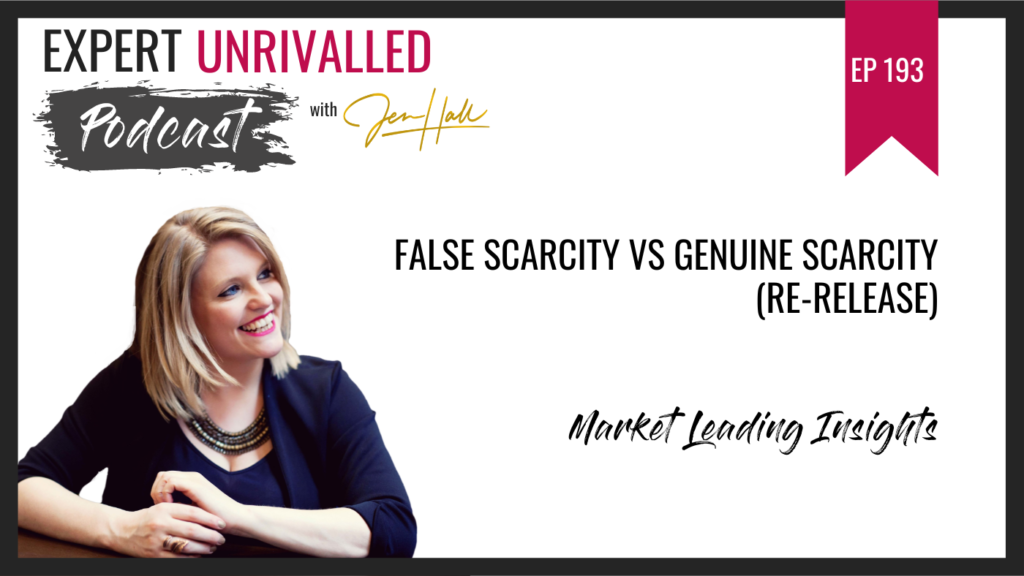I’ve seen the backlash against false scarcity and discussing bad habits within the industry. Certain tactics within marketing are framed negatively and this is not always the case. So I want to drop some truthbombs and bust some myths on what false scarcity means, what it is and what it isn’t.
False Scarcity
When people condemn false scarcity without the full picture, what happens is those with less marketing experience feel like they can’t do things like limit places or set a deadline. False scarcity has an impact on sales.
Some coaches talk about hitting the big time without making scarcity claims or using false scarcity. While I can applaud this, people can look at this when they’ve not yet built the audience size, engagement and kudos so then think they cannot use false scarcity.
We need to have a clearer picture of what strategies in marketing can be used and what will damage your credibility.
What Is False Scarcity?
False scarcity is claiming that there is not enough despite the technology for production or the capacity for sharing. This is the official definition of false scarcity. Yet, it can be a gimmick when people claim there are only X amount of spots available when they can take more. This can turn people off as well.
However, there is far less false scarcity out there than you are led to believe. There is a difference between creating urgency and pushing false scarcity. Genuine urgency can be built through genuine reasons. So, we need to banish the theory that deadlines, limited spots and availability are a false scarcity.
In my research for this episode, I found that people online are bashing false scarcity but not talking about what it is and how it’s different from creating urgency.
Natural urgency is built for the benefit of your clients and the people whom you are serving. I am a fan of creating urgency for both your and your clients’ benefit. Urgency works for making sales and without a sense of urgency, you will see a decline in sales. Claiming urgency doesn’t make you a bad person. Making untrue claims will damage your reputation and this is different.
Ways Of Creating Urgency
1. Be Oversubscribed
Daniel Priestly, author of Key Person of Influence talks about becoming over-subscribed. This is a great strategy for steadily scaling and yes, creating a certain amount of scarcity and exclusivity. Therefore, being over-subscribed means having an environment with a smaller amount of people and therefore they feel special.
Who wouldn’t want their clients to feel special? And give them extra and over-deliver? This is not a bad thing. and it is also beneficial for your business. Let’s say you want to take through a beta group, do you want that group to be huge when you don’t know how it works?
If you take people through a live version first and then try it with quadruple the number of people, you need to be careful as you don’t know how it will work. The dynamics will shift. It is the same with our office. The business started with me and Andy, then Dave joined us and now we have a whole office of people. The dynamics of the office are completely different. It’s a calmer and more controlled space with structure and policies.
We also scaled our training weekends from a small group to a larger group. It takes planning and time so we need to steadily grow to work this out. If you scale too fast, you will risk letting your clients down because you haven’t seen how it will work.
2. Use Deadlines
Again, urgency is naturally created but you also need to call it out in your marketing. Without urgency, people will dilly-dally. I live by deadlines and teach both my clients and my teams to do this as well. Put in mini-deadlines for everything we do. It’s about getting stuck and being productive.
We are all procrastinators. If you say you’re not, it’s because you use a strategy such as deadlines. Without deadlines, we will let work drift and let buying drift. Of course, we are all working at different levels for this, especially if you are neuro-diverse.
Without a deadline, people do not get off the fence. By placing a deadline, you are giving people adequate time to take action. You can set them well in advance. For example, if I am running a sales campaign it takes up a lot of energy. I can’t let that sales campaign go on for a long duration as my energy will fail. In this situation, a deadline is positive for my health and wellbeing as well as for helping my clients make decisions.
Help make decisions
It is a deadline that helped our adventure travel business make just shy of £330k in the last campaign. This is a result of the deadline and around three-quarters came through in the last 24 hours. And it shows how much people will wait until they have to make a decision. Then they will make it. And these people are happy about the decision made.
Having a deadline is a good thing for all parties. It’s good for marketing and to make sure you have the time and energy to give to your clients.
A deadline can happen when a programme is about to start. This is a natural deadline as you can’t have people joining mid-way through. Plus, I shut the doors on certain programmes before it starts so that I have time to prepare. This means my clients get the best from me and they don’t have me still in sales mode.
In this sense, having an early bird deadline rewards clients for booking early and gives me an idea of how popular a programme will be. You can be strategic and still have integrity.
3. Dates Versus Spots
It makes no sense to say you have a limited amount of spots when you can take more. However, there are times when limited spots can be genuine.
Experience over attendees
My masterclass spots are limited because I like to give time for questions and give everyone the chance to get the answers to their question in full. Instead of having loads of people on a webinar-like experience where they don’t feel engaged or being serviced properly.
This is also the first time I’ve run this masterclass so I want to make sure I deliver a good service. Therefore by having fewer people there who are engaged, I can give the best service to them in person. This doesn’t come with inviting hundreds of people to the masterclass.
Equally, when you’re on a masterclass or webinar when there are hundreds of people – how engaged are you? It’s more important to have an experience than passively watching something. Having a small masterclass gives you the best experience and it’s far more rewarding.
Last year I ran six masterclasses and made six figures from them. In the end, they were so popular they were selling out every time. And this was done from a small list – so can you see how this process can also increase the value and make it exclusive?
There is urgency and scarcity but it is there for very good reasons. It is better for myself and the people who I serve.
False Scarcity Versus Genuine Scarcity
The examples above show you how you can leverage genuine scarcity when marketing your programmes. Don’t let people tell you otherwise. It is important to think about your intention behind the urgency. If you are doing it with the intention of greed then that’s not okay. But if you know this will help someone make a good decision and mean that you get the best from your energy, then there is good intention behind it.
Useful links:
Book a Call with Jen – bit.ly/claritycallpodcast
Download my FREE Seven Figure Market Leader Roadmap –http://www.marketleaderleague.com/marketleaderroadmap/
Send your emails to jen@jen-hall.com
Available on Apple iTunes, Spotify & Stitcher (Just search Expert Unrivalled Podcast)

